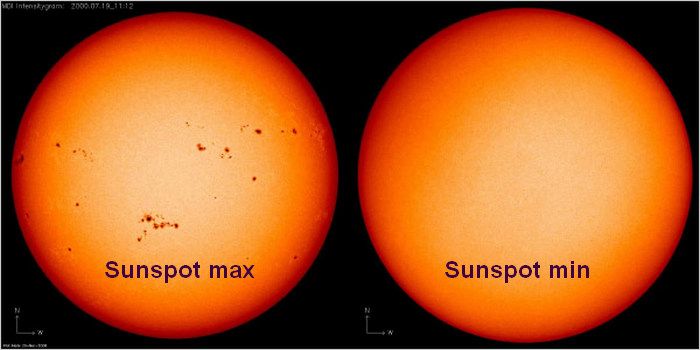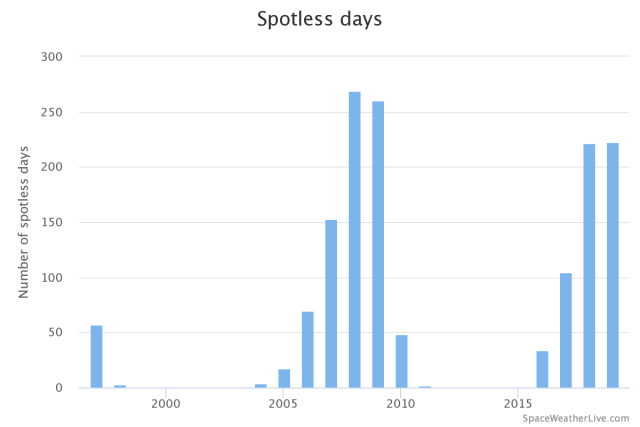THE SUN HAS BEEN SPOTLESS FOR A TOTAL OF 224 DAYS IN 2019, AND COUNTING… LOOMING

GRAND SOLAR MINIMUM - OCTOBER 28, 2019 CAP ALLON
During periods of low solar activity, such as the deep solar minimum we’re in now, the Sun will often be devoid of sunspots.
The below graph shows how many days during a specific year that the earth-facing side of the Sun has been ‘spotless’:

As of Oct 28, the current stretch of days without any observable spots has reached 25, making for a total of 224 spotless days in 2019 so far (or 74%). This means that 2019 has now surpassed the 222 spotless days observed in 2018 with more than 2 months to go.
2019 even looks set to eclipse 2008’s total of 269 spotless days (or 73%), when the Sun had just gone through it’s weakest solar cycle, and consequently deepest solar minimum, of the past 100+ years:

NASA have linked periods of low solar activity to spells of global cooling (here) — but don’t go letting no government agency tell you how it is, go correlate the two yourself using the above ‘International Sunspot Number’ graph.
The Dalton Minimum 1790 to 1830 brought with it a period of lower-than-average global temperatures. The Oberlach Station in Germany, for example, experienced a 2C decline over 20 years, which devastated the country’s food production. The Year Without a Summer also occurred during the Dalton Minimum (in 1816). As did crop failures across Eurasia & the Americas, which led to food riots, famine and ultimately the deaths of millions upon millions of people.
That 40-year temperature decline (1790-1830) matches perfectly with a dip in solar activity.
And so do temperature plunges of the past — preceding the Dalton were the much deeper Maunder and Spörer Grand Solar Minimums.
Taking the Maunder Minimum 1645 to 1715 (as we have far more data for it than the Spörer), we see it’s 70-or-so year spell of global cold, crop loss, and famine again correlates neatly with a sharp decline in solar output. During this Grand Solar Minimum, the Sun was all-but devoid of sunspots for not just years, but decades at a time:

The 400-year Grand Solar Minimum cycle is returning, and the cold is coming back with it.
Sunspots are continuing to become few & far between, of late. And while it’s really anyone’s guess what next year will bring, the likelihood of 2020 surpassing 2019’s spotless days total is very high, as the sun looms inevitably-closer to its next Grand Solar Minimum.
Prepare — grow your own.
Social Media channels are restricting Electroverse’s reach — be sure to subscribe to receive new post notifications by email (the box is located in the sidebar >>> or scroll down if on mobile).
And/or become a Patron, by clicking here: patreon.com/join/electroverse
Any way you can, help us spread the message so others can survive and thrive in the coming times.
Grand Solar Minimum + Pole Shift
For more on the Dalton Minimum, along with NASA’s latest solar forecast, click the article below:

ANOTHER CLIMATE SCIENTIST WITH IMPECCABLE CREDENTIALS BREAKS RANKS: “OUR MODELS ARE MICKEY-MOUSE MOCKERIES OF THE REAL WORLD”
Dr. Mototaka Nakamura received a Doctorate of Science from the Massachusetts Institute of Technology (MIT), and for nearly 25 years specialized in abnormal weather and climate change at prestigious institutions that included MIT, Georgia Institute of Technology, NASA, Jet Propulsion Laboratory, California Institute of Technology, JAMSTEC and Duke University.
In his book The Global Warming Hypothesis is an Unproven Hypothesis, Dr. Nakamura explains why the data foundation underpinning global warming science is “untrustworthy” and cannot be relied on:
“Global mean temperatures before 1980 are based on untrustworthy data,” writes Nakamura. “Before full planet surface observation by satellite began in 1980, only a small part of the Earth had been observed for temperatures with only a certain amount of accuracy and frequency. Across the globe, only North America and Western Europe have trustworthy temperature data dating back to the 19th century.”
From 1990 to 2014, Nakamura worked on cloud dynamics and forces mixing atmospheric and ocean flows on medium to planetary scales. His bases were MIT (for a Doctor of Science in meteorology), Georgia Institute of Technology, Goddard Space Flight Center, Jet Propulsion Laboratory, Duke and Hawaii Universities and the Japan Agency for Marine-Earth Science and Technology.
He’s published 20+ climate papers on fluid dynamics. There is no questioning his credibility or knowledge.
Today’s ‘global warming science’ is akin to an upside down pyramid which is built on the work of a few climate modelers. These AGW pioneers claim to have demonstrated human-derived CO2 emissions as the cause of recently rising temperatures and have then simply projected that warming forward. Every climate researcher thereafter has taken the results of these original models as a given, and we’re even at the stage now where merely testing their validity is regarded as heresy.
Here in Nakamura, we have a highly qualified and experienced climate modeler with impeccable credentials rejecting the unscientific bases of the climate crisis claims. But he’s up against it — activists are winning at the moment, and they’re fronted by scared, crying children; an unstoppable combination, one that’s tricky to discredit without looking like a heartless bastard (I’ve tried).

DATA FALSIFICATION
When arguing against global warming, the hardest thing I find is convincing people of data falsification, namely temperature fudging. If you don’t pick your words carefully, forget some of the facts, or get your tone wrong then it’s very easy to sound like a conspiracy crank (I’ve been there, too). But now we have Nakamura.
The good doctor has accused the orthodox scientists of “data falsification” in the form adjusting historical temperature data down to inflate today’s subtle warming trend — something Tony Heller has been proving for years on his website realclimatescience.com.
Nakamura writes: “The global surface mean temperature-change data no longer have any scientific value and are nothing except a propaganda tool to the public.”
The climate models are useful tools for academic studies, he admits. However: “The models just become useless pieces of junk or worse (as they can produce gravely misleading output) when they are used for climate forecasting.”
Climate forecasting is simply not possible, Nakamura concludes, and the impacts of human-caused CO2 can’t be judged with the knowledge and technology we currently possess. The models grossly simplify the way the climate works.
As well as ignoring the sun, they also drastically simplify large and small-scale ocean dynamics, aerosol changes that generate clouds (cloud cover is one of the key factors determining whether we have global warming or global cooling), the drivers of ice-albedo: “Without a reasonably accurate representation, it is impossible to make any meaningful predictions of climate variations and changes in the middle and high latitudes and thus the entire planet,” and water vapor.
The climate forecasts also suffer from arbitrary “tunings” of key parameters that are simply not understood.
NAKAMURA ON CO2
He writes:
“The real or realistically-simulated climate system is far more complex than an absurdly simple system simulated by the toys that have been used for climate predictions to date, and will be insurmountably difficult for those naive climate researchers who have zero or very limited understanding of geophysical fluid dynamics. The dynamics of the atmosphere and oceans are absolutely critical facets of the climate system if one hopes to ever make any meaningful prediction of climate variation.” Solar input is modeled as a “never changing quantity,” which is absurd.
“It has only been several decades since we acquired an ability to accurately monitor the incoming solar energy. In these several decades only, it has varied by one to two watts per square meter. Is it reasonable to assume that it will not vary any more than that in the next hundred years or longer for forecasting purposes? I would say, No.”
Read Mototaka Nakamura’s book for free on Kindle — arm yourself with the facts, and spread them. Facts such as these little nuggets (all lifted/paraphrased from the book): “[The models have] no understanding of cloud formation/forcing.” “Assumptions are made, then adjustments are made to support a narrative.”“Our models are mickey-mouse mockeries of the real world.”
SOLAR FORCING
Solar output isn’t constant, IPCC. And the modulation of cloud nucleation is a key consequence. During solar minima, like the one we’re entering now, the sun’s magnetic field weakens and the outward pressure of the solar wind decreases. This allows more Cosmic Rays from deep space to penetrate our planet’s atmosphere. These CRs have been found to nucleate clouds (Svensmark et al). And clouds are a crucial player earth’s climate.
As Roy Spencer, PhD. eloquently writes:
“Clouds are the Earth’s sunshade, and if cloud cover changes for any reason, you have global warming — or global cooling.”
WHO and WHAT is behind it all ? : >
The bottom line is for the people to regain their original, moral principles, which have intentionally been watered out over the past generations by our press, TV, and other media owned by the Illuminati/Bilderberger Group, corrupting our morals by making misbehavior acceptable to our society. Only in this way shall we conquer this oncoming wave of evil.
Commentary:
Administrator
All articles contained in Human-Synthesis are freely available and collected from the Internet. The interpretation of the contents is left to the readers and do not necessarily represent the views of the Administrator. Disclaimer: The contents of this article are of sole responsibility of the author(s). Human-Synthesis will not be responsible for any inaccurate or incorrect statement in this article. Human-Synthesis grants permission to cross-post original Human-Synthesis articles on community internet sites as long as the text & title are not modified.
The source and the author's copyright must be displayed. For publication of Human-Synthesis articles in print or other forms including commercial internet sites. Human-Synthesis contains copyrighted material the use of which has not always been specifically authorized by the copyright owner. We are making such material available to our readers under the provisions of "fair use" in an effort to advance a better understanding of political, economic and social issues. The material on this site is distributed without profit to those who have expressed a prior interest in receiving it for research and educational purposes. If you wish to use copyrighted material for purposes other than "fair use" you must request permission from the copyright owner.